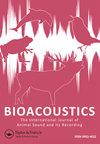Environmental factors influencing call propagation in Pithecopus nordestinus: testing the acoustic adaptation hypothesis
IF 1.5
4区 生物学
Q2 ZOOLOGY
Bioacoustics-The International Journal of Animal Sound and Its Recording
Pub Date : 2022-03-03
DOI:10.1080/09524622.2022.2042855
引用次数: 1
Abstract
ABSTRACT The acoustic adaptation hypothesis (AAH) states that the acoustic signal of a species must propagate better in its native habitat. Studies have shown that certain anuran species modify acoustic parameters according to the environment where they are calling. However, these studies did not verify if these modifications improved the call’s transmission. We investigated whether advertisement calls of Pithecopus nordestinus (Phyllomedusidade)propagated more efficiently in two habitats where the species has evolved over generations (Caatinga and Atlantic Forest) and, according to the predictions of the AAH, whether specific acoustic parameters (number of pulses, interval between pulses and dominant frequency) maximise transmission. We measured the efficiency of the transmitted signal (natural and synthesised calls) in different environments. Our results showed that natural calls from Caatinga habitats were less degraded. We found that synthetised calls with shorter intervals between pulses propagated just as well in both the Caatinga and the Atlantic Forests. Finally, the dominant frequency was influenced by the propagation environment and, synthetised calls with higher frequencies showed less degradation when propagated in the Caatinga. Our results indicate that not all differences found in the acoustic parameters of anuran calls in distinct environments can be attributed to the acoustic adaptation hypothesis.环境因素对东北棘猴叫声传播的影响:声学适应假说的检验
声学适应假说(AAH)认为物种的声信号必须在其原生栖息地更好地传播。研究表明,某些无尾猿物种会根据它们发出叫声的环境改变声音参数。然而,这些研究并没有证实这些修改是否改善了呼叫的传输。我们研究了北地鼠(Phyllomedusidade)的广告叫声是否在两个物种已经进化了几代的栖息地(Caatinga和Atlantic Forest)中更有效地传播,以及根据AAH的预测,特定的声学参数(脉冲数、脉冲间隔和主导频率)是否最大化了传播。我们测量了在不同环境下传输信号(自然和合成呼叫)的效率。结果表明,来自Caatinga栖息地的自然叫声退化程度较低。我们发现脉冲之间间隔较短的合成叫声在卡廷加森林和大西洋森林中传播得一样好。最后,主导频率受传播环境的影响,较高频率的合成呼叫在Caatinga中传播时衰减较小。我们的研究结果表明,并非所有在不同环境中发现的无尾猿叫声的声学参数差异都可以归因于声学适应假说。
本文章由计算机程序翻译,如有差异,请以英文原文为准。
求助全文
约1分钟内获得全文
求助全文
来源期刊
CiteScore
4.50
自引率
0.00%
发文量
25
审稿时长
>12 weeks
期刊介绍:
Bioacoustics primarily publishes high-quality original research papers and reviews on sound communication in birds, mammals, amphibians, reptiles, fish, insects and other invertebrates, including the following topics :
-Communication and related behaviour-
Sound production-
Hearing-
Ontogeny and learning-
Bioacoustics in taxonomy and systematics-
Impacts of noise-
Bioacoustics in environmental monitoring-
Identification techniques and applications-
Recording and analysis-
Equipment and techniques-
Ultrasound and infrasound-
Underwater sound-
Bioacoustical sound structures, patterns, variation and repertoires

 求助内容:
求助内容: 应助结果提醒方式:
应助结果提醒方式:


